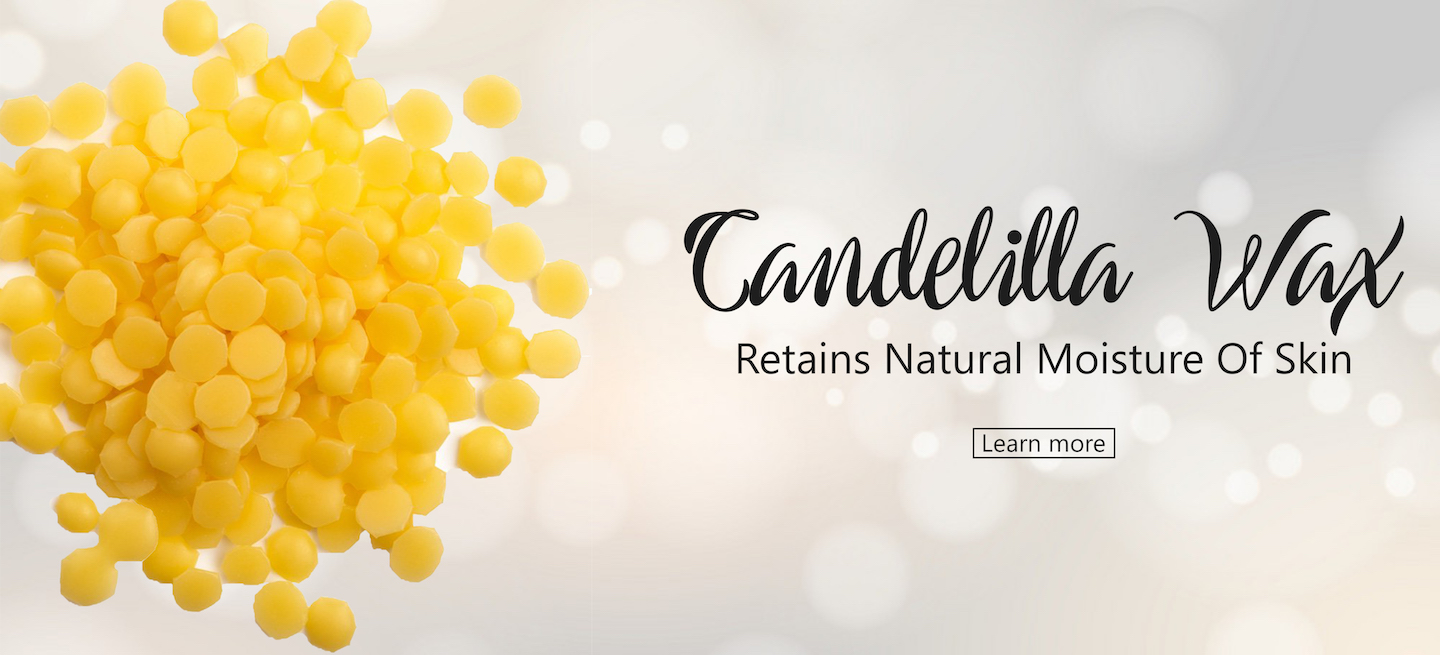Candelila Wax
WHAT IS CANDELILLA WAX?
Candelilla Wax – pronounced can-deh-LEE-ya – is a “vegetable” wax that is obtained from the Euphorbia cerifera botanical, better known as the small, wild Candelilla shrub. Its name, which means “little candle,” is a tribute to its history of being first used in candle making. It may also be a reference to the upright growth of the plant’s stems, which resemble pencils or, more fittingly, candles – even more so because of their waxy outer layer; in nature, Candelilla wax forms the thick coating of its source plant’s leaves and stems and functions as the plant’s defense mechanism against the severe weather conditions of the desert. As a water-proofing agent, it protects the plant against heat and dryness, thereby preventing moisture loss.
Candelilla Wax is collected by boiling the full-grown plant in a solution of water and Sulfuric Acid. The latter is meant to prevent the wax and water from forming an emulsion, which the rolling water could potentially facilitate. When the crude wax finally rises to the surface of the water and appears as a creamy, opaque, light-brown or yellow foam – called “cerote” – it is skimmed off. Next, the wax is melted again then filtered through Activated Carbon as well as Fuller’s Earth Clay. After this, it enters a filter press, is bleached with Hydrogen Peroxide, which later becomes neutralized, and is filtered once more. The final product is a hard, light-yellow wax that can be easily shattered due to its brittleness. After the wax has been further processed into blocks, lumps, pastilles, pellets, flakes, granules, or powder, it is ready to be used.
The plant-based source of this wax makes it ideal for formulating vegan products. Its texturizing property as well as its ability to create barriers between the skin and harsh environmental stressors makes it a valuable ingredient in products such as lip balms. Its protective and softening qualities also make it a popular additive in moisturizers. With an easy ability to combine well with other waxes, including Paraffin and Carnauba, it complements them primarily by helping to extend their beneficial properties. It is also reputed to be an effective substitute for them.
CANDELILLA WAX PROPERTIES
Candelilla Wax functions as a thickening and hardening agent, a plasticizer, a viscosity modifier, an emollient, and a skin-protective barrier agent that helps prevent the skin from losing moisture. It contributes shine and functions as a stabilizer, an emulsifier, a fast-absorbing lubricant, and a nourishing skin conditioner. Candelilla Wax is reputed to help reduce the appearance of stretch marks as well as the signs of aging, such as wrinkles and age spots. Furthermore, it is said to hydrate parched and scaly skin for enhanced smoothness.
Candelilla Wax is known to be an effective binding agent that easily fuses ingredients. This quality makes it easy to incorporate it into most other waxes as well as resins, both natural and synthetic. This emulsifying property mainly helps water and oil constituents to bind together with a smooth uniformity, a necessary effect for products like moisturizers, such as lotion bars, creams, and balms, to which Candelilla Wax is known to offer hydrating properties and easy spread over the skin’s surface.
Its firming effect means that it can be used to set and solidify formulas for various types of makeup, such as stick foundations, eye shadow, or lip products, to which it provides an ideal “slip” without causing the products to become too hard. This firming property is also beneficial for candle formulations, as Candelilla Wax contributes hardness and smoothness to the final product.
APPLICATIONS FOR CANDELILLA WAX
Candelilla Wax is insoluble in water but is highly soluble in oils and alcohols. To add Candelilla Wax to product formulations, begin by melting it before incorporating it into the chosen recipe. When adding it to formulas that require emulsification, incorporate it into their oil phases.
PRODUCT TYPE & FUNCTION
When added to this kind of formulation…
- Face, Hand, or Foot Creams
- Lubricants, Lotions, Sunscreens
- Salves, Ointments, Balms
- Pomades
- Lipsticks, Lip Balms, Lip Gloss, Mascaras
EFFECTS
- Candelilla Wax functions as a(n):
- Skin Protectant
- Fast-Absorbing Moisturizer
- Nourishing Conditioner
- Hardening Agent
- Thickening Agent
- Plasticizer
- Viscosity Modifier
- Stabilizer Emulsifier
- Lubricant Substitute for Beeswax
It helps to:
- Contribute shine/gloss, especially to lip products
- Provide smoothness and hardness to products that require a high melting point and a stiff consistency
- Add texture and structure
- Give solid and stick products their structures by enhancing the viscosity of their oil parts
- Contribute a level of firmness to particular textures, such as that of eyeshadows, without causing them to harden
- Emulsify immiscible liquids in to prevent them from separating in formulations with creamy consistencies
- Provide excellent glide/slip to cosmetics formulations for easy spreadability as well as easy removability
- Enhance rate of absorption into skin Contribute a faint sweet scent that is reminiscent of Beeswax
- Form a protective film on the skin’s surface to help repel water Create barrier products, such as balms Blend natural powder/mineral colorants into a formula Complement other waxes, such as Beeswax


